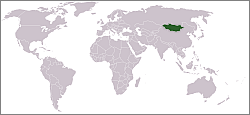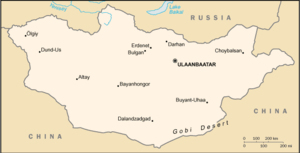Mongolia
|
|
- For the region of the same name, see Mongolia (region)
Mongolia (Khalkha Mongolian: Монгол Улс) is a landlocked nation in central Asia, bordered by Russia to the north and the People's Republic of China to the south. It was the center of the Mongol Empire of the 13th century, but was ruled by the Chinese Qing dynasty from the end of the 17th century until an independent government was again formed with Soviet assistance in 1921. After the fall of the Soviet Union, Mongolia became a democracy. The 18th largest country in the world, Mongolia has very little arable land: much of its area is grassland, with mountains in the north and west and the Gobi Desert in the south. Little over 30 percent of the population are nomadic or semi-nomadic Tibetan Buddhists of the Mongol ethnicity. Over 50 percent of the population reside in capital city - Ulaanbaatar.
| |||||
| National motto: n/a</font> | |||||

| |||||
| Official language | Mongolian | ||||
| Capital | Ulaanbaatar Template:Coor dm | ||||
| President | Natsagiyn Bagabandi | ||||
| Prime Minister | Tsakhiagiyn Elbegdorj | ||||
| Area - Total - % water | Ranked 18th 1,565,000 km² 0.6% | ||||
| Population - Total (2003) - Density | Ranked 134th 2,712,315 1.73/km² | ||||
| Independence - Date | from China July 11, 1921 | ||||
| Currency | tugrug (MNT) | ||||
| Time zone | UTC +7, +8 | ||||
| National anthem | Bügd Nairamdakh Mongol | ||||
| Internet TLD | .mn | ||||
| Calling Code | 976 | ||||
| Contents |
History
Main article: History of Mongolia
In the 13th century, Mongolia was the center of the Mongol Empire, the largest contiguous land empire in world history. After more than a century of power, the Mongol Empire ended and Mongolia fell back into a state of internal struggle and feuds, which paved the way for the Manchu conquest of Inner Mongolia in 1636 and the submission of Outer Mongolia in 1691. Both Inner and Outer Mongolia declared independence in 1911, but only Outer Mongolia succeeded, with Russian help. After the October Revolution in Russia, Chinese troops re-occupied Outer Mongolia in 1919, but were caught in the middle when White and Red Russian armies extended the Russian Civil War into (Outer) Mongolian territory, and driven out in 1921. In 1924, the Mongolian People's Republic was proclaimed. Mongolia aligned closely with the Soviet Union. Politicians who demanded a more independent course, like Bodoo or Dandzan, were quickly toppled and executed. In 1928 Horloogiyn Choybalsan rose to power. Under his rule, forced collectivization, purges, and the destruction of the Lamaist monasteries in 1937, left more than 10.000 people dead.
During World War II, the USSR defended Mongolia against Japan during the Battle of Halhin Gol. Mongolian forces also took part in the Soviet offensive against Japanese forces in Inner Mongolia of August 1945 (see Operation August Storm). The threat of Mongolian forces seizing parts of Inner Mongolia induced the Republic of China to recognize Outer Mongolia's independence, provided that a referendum was held. The referendum took place on October 20, 1945, with, according to official numbers, 100% of the electorate voting for independence. After the establishment of the People's Republic of China, both countries recognized each other on October 6, 1949.
After Choybalsan died in Moscow on January 26 1952, Yumjaagiyn Tsedenbal took power. In 1956 and again in 1962, Choybalsan's 'personality cult' was condemned. Mongolia continued to closely align itself with the Soviet Union, especially after the Sino-Soviet split of the late 1950s. While Tsedenbal visited Moscow in August 1984, the parliament announced his retirement and replaced him with Jambyn Batmonh.
In 1990, the Communist Party relinquished control over the government, paving the way for a new constitution in 1992 that abolished the People's Republic and created a hybrid parliamentary/presidential state.
Politics
Main article: Politics of Mongolia
Until June 27, 2004 the predominant party in Mongolia was the Mongolian People's Revolutionary Party or MPRP, which was formed by Mongolia's communist leaders after the end of the Cold War. The main opposition party was the Democratic Party or DP, which controlled a governing coalition from 1996 to 2000. From 2000 to 2004 MPRP was back in power, but results of the 2004 elections required the establishing of the first ever coalition government in Mongolia between the MPRP and MDC (Motherland Democratic Coalition).
The state employs a dual executive system with an elected president as head of state and a prime minister as head of government. The legislature, or State Great Hural, has one chamber with 76 seats and is chaired by the speaker of the house.
Provinces
Main article: Provinces of Mongolia
Mongolia is split in to 21 provinces (aimag), Ulaanbaatar (the capital) is a municipality with provincial status.
- Arhangay
- Bayan-Ölgiy
- Bayanhongor
- Bulgan
- Darhan-Uul
- Dornod
- Dornogovĭ
- Dundgovĭ
- Govĭ-Altay
- Govĭsümber
- Hentiy
- Hovd
- Hövsgöl
- Ömnögovĭ
- Orhon
- Övörhangay
- Selenge
- Sühbaatar
- Töv
- Ulaanbaatar (municipality)
- Uvs
- Zavhan
Geography
Main article: Geography of Mongolia
The Mongolian heartland consists of relatively flat steppes. The southern portion of the country is taken up by the Gobi Desert, while the northern and western portions are mountainous.
Most of the country is hot in the summer and extremely cold in the winter, with temperatures dropping as low as -30°C (-22°F). The country is also subject to occasional harsh climactic conditions known as zud or dzud.
Ulaanbaatar has the coldest average temperature of any national capital in the world.
Economy
Main article: Economy of Mongolia
Mongolia's economy is centered on Agriculture and Mining. Majority of population lives on their live stocks, mainly cow, sheep, goat, horse and camel(bactrian). Many industrial facilities were closed down on the wake of capitalism and end of Soviet Union, which supported those largely loss-making factories. In Mining, main products are oil, coal, and copper, with smaller industries in molybdenum, tungsten, and phosphate mining. Following decades of state-run enterprise, the economy has undergone an often-painful transition to capitalism. There are currently over 30,000 independent businesses in Mongolia, chiefly centered around the capital city. Outside the cities, most Mongolians engage in sustenance herding.
GDP per capita is about $420. Although GDP has risen steadily since 2002, the state is still working to overcome a sizable trade deficit. A massive ($11 billion) foreign debt to Russia was settled by the Mongolian government in 2004 with a $300 million payment; this reduced value was accepted due to Mongolian hardship and losses of human lives during the Soviet Era. Mongolia joined the World Trade Organization in 1997 and now exports cashmere, minerals, and food products to Russia, United States, China, Japan, Italy, and other countries
Demographics
Main article: Demographics of Mongolia
Most Mongolians are Mongol in descent: there are also smaller populations of Kazakh and Tungus people. The predominant religion is Tibetan Buddhism. As in many developing countries, Mongolia's young and rapidly growing population has put great strains on its economy.
Culture
Main article: Culture of Mongolia
See also: Music of Mongolia
Miscellaneous topics
- Communications in Mongolia
- Transportation in Mongolia
- Military of Mongolia
- Foreign relations of Mongolia
- Public holidays in Mongolia
External links
- CIA World Factbook - Mongolia (http://www.cia.gov/cia/publications/factbook/geos/mg.html)
- Dmoz - Mongolia Links (http://dmoz.org/Regional/Asia/Mongolia/)
- Mongoluls.net - Information on Mongolia (http://mongoluls.net/)
- Mongolia Today Magazine (http://www.mongoliatoday.com/)
- Mongolian Tourist Board (http://www.mongoliatourism.gov.mn/)
- Mongolian Open Government (http://www.open-government.mn) (in Mongolian)
- Mongolia Gateway portal (http://www.gateway.mn/index.php?newlang=english)
- Images of Mongolia (http://www.mongolialife.com)
- Flags and arms of the aymags of Mongolia (http://www.geocities.com/ulsuud)
- 2500 pictures of travel in Mongolia (http://www.ub-mongolia.mn)
- PhotoGlobe - Central Mongolia (http://www.photoglobe.info/gb_mongolia/) offers high quality, commented photos of Central Mongolia together with GPS coordinates
- Country Studies - Mongolia (http://www.photoglobe.info/ebooks/mongolia/) offers background information on Mongolia
- 21 days In Mongolia (http://www.21DaysInMongolia.co.uk/) Backpackers gallery and travel diary
| Countries in Central Asia |
|---|
|
China (PRC) | Kazakhstan | Kyrgyzstan | Mongolia | Russia | Tajikistan | Turkmenistan | Uzbekistan |
ca:Mongòlia cs:Mongolsko da:Mongoliet de:Mongolei et:Mongoolia es:Mongolia eo:Mongolio fa:مغولستان fr:Mongolie ko:몽골 hr:Mongolija id:Mongolia is:Mongólía it:Mongolia he:מונגוליה la:Mongolia lt:Mongolija li:Mongolië mi:Mongōria ms:Mongolia zh-min-nan:Bông-kó· mn:Монгол улс nl:Mongolië nds:Mongolei ja:モンゴル国 nb:Mongolia nn:Mongolia os:Монголи pl:Mongolia pt:Mongólia ro:Mongolia ru:Монголия sk:Mongolsko sl:Mongolija fi:Mongolia sv:Mongoliet th:ประเทศมองโกเลีย zh:蒙古国


